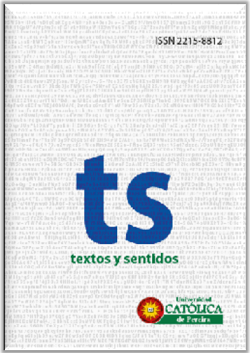Analysis of predictive factors in use of psychoactive substances
Keywords:
Consumption, Psychoactive, Cognitive variables, FamilyAbstract
Various studies show that consumption ofpsychoactive substances has increased over the years.This increase is associated with nature cognitivefactors emotional- affective and instability in familyrelationships; Factors that may affect academic,cognitive and behavioral areas of students. We setout to analyze the effect of cognitive variables andfamily on the consumption of alcohol, tobaccoand marijuana and. 78 young people were assessedbetween 16 and 28 years old. 16% were male and84% female, all from a private university in Arequipa,Peru. The Tower of Hanoi was applied to measureplanning; the Simon Task, for inhibitory control andthe Iowa Gambling Task for decision-making. Threequestionnaires were applied; AUDIT for alcoholconsumption, sociodemographic variables and toinquire about nicotine and marijuana. It is observedthat there is a certain part of the gender effect on thefrequency and intensity of alcohol; on the other handthe extent of planning is affected by the frequencyand intensity of alcohol and nicotine. Furthermore,no significance is given to the dependent variablesand marijuana.
References
Babor, T., Higgins-Biddle, J., Saunders, J. & Monteiro, M., (2001). AUDIT: Cuestionario de Identificación de los Trastornos Debidos al Consumo de Alcohol. Organización Mundial de la Salud
Barca, A., Otero, J.M., Mirón, L. & Santórum, R., (1986). Determinantes familiares, escolares y grupales del Consumo de drogas en la adolescencia. Implicaciones para el tratamiento Estudios de Psicología, 25, 103-109
Bechara, A., Damasio, A.R. & Damasio, H., (2000). Emotion, decision making and the orbito-frontal cortex. Cerebral Cortex, Vol.10, pp. 295-307.
Bechara A. (2005) Decision-making, impulse control and loss of willpoper to resist drugs: a neurocognitive perspective. Nature neuroscience , 8, 1.458-1.463.
Beverido Sustaeta, P. & Gogeascoechea Trejo, M., (2010). Percepción del riesgo y prevalencia del consumo de drogas en estudiantes de secundaria del estado de Veracruz. Instituto de ciencias de la salud.
Brinez-Horta, J.A., (2001). Diferencias de género en problemas con el alcohol, según el nivel de consumo. ADICCIONES, Vol. 13(4), pp. 439-455
Brody, A., Mandelkern, M., Jarvik, M., Lee, G., Smith, E., Huang, J., Bota, R., et al. (2004). Differences between smokers and nonsmokers in regional gray matter volumes and densities. Biological Psychiatry, 55(1), 77- 84. Doi:10.1016/S0006 3223(03)00610-3
Comunidad Andina (CAN), (2012). II Estudio epidemiológico andino sobre el consumo de drogas en la población universitaria: informe regional. Biblioteca Nacional de Perú, N° 201300999.
Crews, F., Boettiger, C., (2009). Impulsivity, frontal lobes and risk of addiction. Pharmacology, Biochemistry and Behavior. 93, 237-247
Cueva, G., (2012). Violencia y adicciones: problemas de salud pública. Revista Peruana de Medicina, Vol. 29.1, pp. 99-103
DEVIDA, (2009). III Estudio Nacional: Prevención y consumo de drogas en estudiantes de secundaria, Resultados nacionales Perú.
Díez Hernández, I., (2003). La influencia del alcohol en la sociedad. Osasunaz, Vol. 5, pp. 177.190.
Durazzo, T., Meyerhoff, D., & Nixon, S. (2010). Chronic cigarette smoking: implications for neurocognition and brain neurobiology. International journal of environmental research and public health, 7(10), 3760 91.doi:10.3390/ ijerph7103760
García, C. (1990). Opiáceos. Serie: Qué son las drogas. México: Árbol
García M. (2009), Manual de Neuropsicología Clínica, España, Pirámide
García-Molina, A, Enseñat-Cantallops, A., Tirapu-Ustárroz, T & RolgRovira, T., (2009). Maduración de la corteza prefrontal y desarrollo de las funciones ejecutivas durante los primeros años de vida. Revista neurológica, Vol. 48(8), pp. 435-440.
Gruber, S.A., y Yurgelun-Todd, D.A. (2001). Neuropsychological correlates of drug abuse. En M.J. Kaufman, (ed.) Brain imaging in substance abuse: research, clinical and forensic applications. New Jersey: Humana Press Inc. Totowa
Lezak, M.D. (2004). Neuropsychological assessment. New York: Oxford University Press.
Liao, Y, Tang, J., Liu, T., Chen, X. & Hao, W., (2010). Differences between smokers and non-smokers in regional gray matter volumes: a voxel-based morphometry study. Adicction Biology, Vol.10, pp. 1-4.
Merchan Clavelino, A., (2014). Efectos neuropsicológicos del consumo de drogas legales en jóvenes universitarios. Departamento de Psicología Clínica, Experimental y Social.
Merikangas, K.R., Dierker, L. y Fenton, B. (1998). Familial factors and substance abuse: Implications for prevention. En R.S. Ashery, E.B.
Robertson y K.L. Kump fer (Eds.), Drug abuse prevention through family interventions. NIDA Research Monograph no. 177, 12-41. Rockville, MD: National Institute on Drug Abuse.
Sánchez Pardo, L. (2005). Los adolescentes y el cannabis. Guía de adolescentes. Valladolid: Junta de Castilla y León.
Simon, S.L., Domier, C.P., Sim, T., Richarsdson, K., Rawson, R.A. & Ling, W., (2002). Cognitive performance of current methamphetamine and cocaine abusers. Journal of addictive diseases, Vol. 21(1), pp. 61-74
Sullivan, E.V., Rosenbloom, M.J., y Pfefferbaum, A. (2000). Pattern of motor and cognitive performance in detoxified alcoholic men. Alcoholism Clinical and Experimental Research, 24, 611-621.
Tziraki, S., (2012). Trastornos mentales y afectación neuropsicológica relacionados con el uso crónico de cannabis. Revista Neurológica; Vol.54, pp. 750-60.
United Nations Office on Drugs and Crime (UNODC), (2015). World drug Report. Division for Policy Analysis and Public Affairs, Vol.1.
Zeigler, D., Wang, C., Yoast, R., Dickinson, B., McCaffree, M., Robinowitz, C., et al. (2005) The neurocognitive effects of alcohol on adolescents and college students. Prev Med.40(1):23-32., et al.

